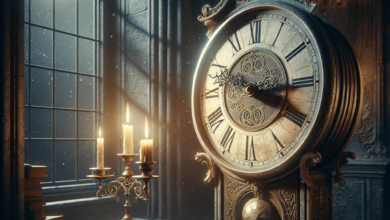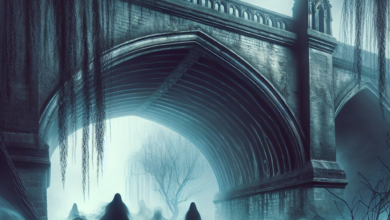The Portrait That Knew Too Much
In the heart of London, beneath the gray shadows of the towering Thames, stood the Bleakwood Gallery, a long-forgotten repository of forgotten art. Once a thriving center of activity, it was now a refuge for dust and cobwebs, its charm dulled by the indifferent passage of time. Just outside its weathered doors, life pulsed in the busy streets, yet inside, a kind of quiet madness reigned as paintings—more than mere strokes of paint—held secrets long buried.
The gallery’s soul was tied to a mysterious painting known as The Portrait of Victor Blackwood. The image depicted a gaunt man draped in shadows, his piercing gaze capable of unsettling even the most unflinching observer. Painted in hues of dark blues and melancholic browns, the piece seemed to radiate unease. Legends hinted that the painting possessed a consciousness of its own, that the artist had imbued it with the essence of the subject, a notorious figure in 19th-century society—a brilliant, but deeply troubled inventor whose life had ended in scandal and tragedy.
Most people dismissed such notions as nonsense, but for Eleanor Hastings, the reluctant curator of the Bleakwood Gallery, the portrait was a source of obsession. She would often find herself gazing into the painting, desperate to understand the secrets it held. After a long day of cataloging other art pieces, she would steal moments alone with Victor, the lines of his troubled face intertwining with her thoughts.
As a new moon glimmered faintly through the gallery window one evening, Eleanor’s routine took a curious turn. While cleaning dust from the frame, she noticed a small, almost imperceptible inscription near the bottom—a script barely discernible, hidden away like a secret. Leaning closer, Eleanor’s heart quickened. The words seemed sinister yet captivating:
"In shadows I dwell, truth is my prison."
A chill ran down her spine, and she felt the air around her shift. A storm of intrigue enveloped her. What did it mean? Did the portrait truly have a hidden narrative, a revelation waiting to be uncovered? The deeper she probed, the more she found herself spinning into a web of mystery entangled with Victor’s haunted past.
Days turned to weeks, and Eleanor immersed herself in research. Books fell open at dusty pages adorned with Victor Blackwood’s likeness; articles spoke of his groundbreaking inventions, but they also whispered of his downfall, a biography riddled with unanswered questions and inexplicable events. As she gathered mentions of Victor’s life, she encountered a pattern: the more she learned, the more the painting’s eyes seemed to follow her, watching her unravel clues only it could hold.
One afternoon, her discoveries led her to a forgotten diary, tucked away within the gallery archives. Its pages had yellowed and curled with age, but the ink remained vibrant, speaking of Victor’s struggles and dark obsessions. Eleanor felt a connection to the man, a tragic affinity, as she read tales of his brilliance overshadowed by madness.
“A light capable of illuminating the universe,” he wrote of his ambition, “yet trapped in the shadows of my mind.”
Every night after work, Eleanor could be found on the gallery’s tattered couch, thumbing through the diary as her eyes grew heavy, often falling asleep with its pages open. It was there, in the liminal state between wakefulness and dreams, that Victor began to invade her subconscious.
In elusive dreams, Victor appeared, a ghostly silhouette stepping out of the two-dimensional world of the canvas. His voice, an echo that reverberated through her thoughts, was articulate and urgent. “Free me,” he would plead, a desperate urgency threading each word. The dreams became more vivid; the boundaries of reality blurred as the haunting presence of Victor seeped into her life.
Eleanor consulted experts, seeking to decipher the meaning behind Victor’s final days. Historians spoke of a failed invention that could harness light and manipulate energy—a device promising to revolutionize humanity—but ultimately leading to rumors of treachery, madness, and a vanishing act that left only the portrait behind. Each mention of the invention sent a shiver down Eleanor’s spine, compelling her to dig deeper.
One evening, as she combed through the final pages of the diary, she read of a secret experiment, one that Victor himself believed could “unlock the very fabric of reality.” He had grown obsessed with an elusive theorem, scribbling notes hurriedly before his mind unraveled. He had gone into hiding, fearing not just the repercussions of failure but something more sinister—a hidden enemy.
In that moment, the air thickened around Eleanor, as if the gallery itself held its breath, waiting for her to take the next step. The mystery of Victor Blackwood was no longer a curiosity; it had become a haunting call to adventure, beckoning her to uncover the truth that lay obscured in shadows. With a resolve she’d never fully possessed, she set out to follow the threads of Victor’s life beyond the gallery’s confines.
Her journey led her to forgotten corners of London, hidden libraries, and obscure auction houses where whispers of Victor’s lost inventions lingered. Eleanor began to meet strange figures—antique dealers, collectors, and conspiracy theorists who believed the tale of Victor’s alternate universe was real. Each person she encountered seemed to deepen the layers of mystery surrounding the portrait and its subject.
One distinguished collector, a spry old man with sparkling eyes, had acquired rare notebooks that once belonged to Victor. “He was a genius but also consumed,” he remarked after Eleanor shared her fascination. “He drew too close to the abyss. Do you know the legend of the Eclipse Chamber?”
Eleanor’s curiosity ignited. The collector spun tales of a hidden laboratory where Victor had experimented, rumored to be buried beneath the very streets of London. “They say he had opened a door—one that connected to realities beyond our comprehension,” he whispered, his voice barely above a breath.
With flashing images of Victor’s lingering gaze, Eleanor felt propelled. She couldn’t ignore the sense of urgency in her chest. Armed with the collector’s maps and Victor’s notes, she returned to the gallery and began to chart her course. She would uncover the truth; she would find the Eclipse Chamber.
Days melted into weeks as she navigated the underbelly of London, traversing through strange alleys and hidden doors. Night after night, she crawled through sewers and cramped tunnels on a quest lacking clarity. Each inch she descended through the city felt like peeling layers of history, shadowed by a new dance of terror.
Finally, after weeks of harrowing exploration, she stumbled upon an unmarked door, concealed behind the crumbling masonry of a dilapidated building. Apprehensively, she pushed it open, and a gust of stale air welcomed her into a vast chamber filled with an odd mix of mechanical contraptions and mirrors, casting distorted reflections.
In the chamber’s center stood a massive device, a hodgepodge of brass and glass, its purpose undecipherable but ominously alluring. A stillness hung in the air, charged with the energy of the long-lost inventor. Eleanor’s heart raced as fragments of Victor’s diary danced through her mind—his fears, his obsession, and the ominous line: "The door must remain shut."
But curiosity triumphed over caution. She approached the machine, her fingers brushing against aged levers and intricate gears. With trembling hands, she powered it up. The room shimmered, giving way to a buzz, a sound growing into a cacophony that rattled her bones. The air shifted again, and suddenly the world around her warped, revealing fragments of another reality.
Through an archway of light, Eleanor glimpsed distorted versions of her own life—moments that twisted into fantastic, nightmarish forms. Each echo was a distorted reflection, a dark path of possibilities. Time surged as her breaths quickened. From the corner of her eye, she saw a flicker: there was Victor! In one vision, he languished in despair; in another, he held triumph in his hands.
As she reached out toward the shimmering passage, she could feel Victor’s essence flooding through her being. “You’ve found it, Eleanor!” he cried, his voice layering over the chaos. “But it demands a price! You can unlock the truth, but along with it, all that I bore must be reckoned with.”
She hesitated, visions swirling mercilessly around her. To confront this power could liberate Victor from his torment, but could she handle the truth? Could she face the shadows along with the light?
In a final moment of clarity, Eleanor pulled back, stepping away from the portal. “I will not free you at any cost, Victor! You belong in your own world, not in mine!”
With a flick of her wrist, she pulled levers, pushed buttons, and with one final motion, the machine sputtered, its power fading, collapsing the vision. The chamber reverberated with the force of cosmic energy before resuming a hushed stillness.
Eleanor staggered back, breathless. She felt the weight of her choice—the burden of knowledge now lightened, if only a fraction. As she emerged from the darkened chambers, she realized that the portrait in the gallery no longer held the same power over her. She had glimpsed the abyss but resisted its pull.
When she stepped through the sun-drenched streets of London once more, the sky hung low with clouds, shadows stretching across the pavement. The Bleakwood Gallery loomed in the distance, and for the first time, Eleanor felt free. Victor’s portrait remained, but now it was just that—a painting, an echo of history, no longer a haunting presence.
Yet the knowledge she bore remained etched in her heart—a story lingering in the silence, whispering of what had been. If there were shadows in the art, there were also lights—infinitesimal sparks of resurrection from darkness, unveiling the art of being human, imperfect and real. The saga of Victor Blackwood lived on, not as a prisoner in a canvas, but as a tale threading through time, leading those curious enough to seek their truths—forever destined to wander the line between shadows and light.
In a realm where portraits can talk and history is never truly gone, Eleanor found her own reflection had changed, intertwined with Victor’s tragic tale but forming a new beginning as colors danced across the canvas of her life.





